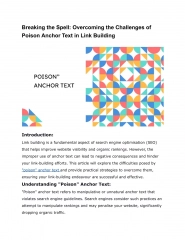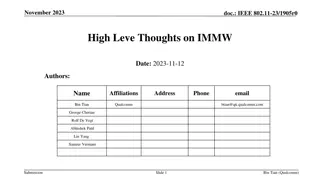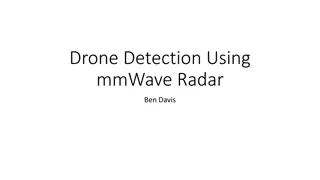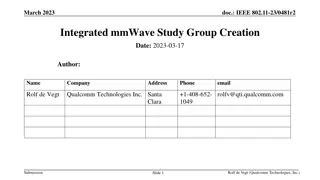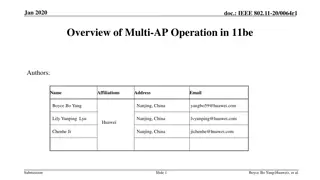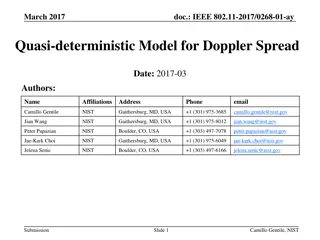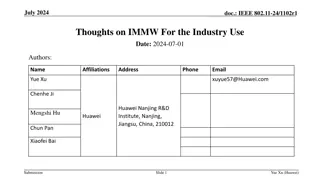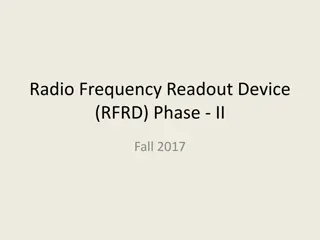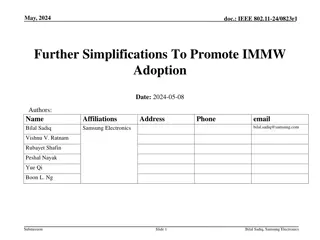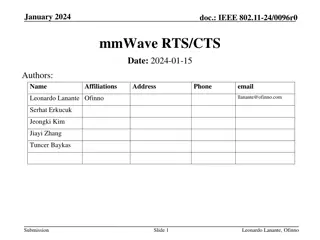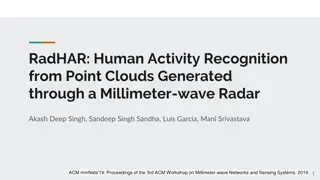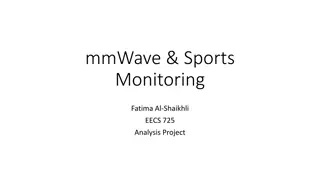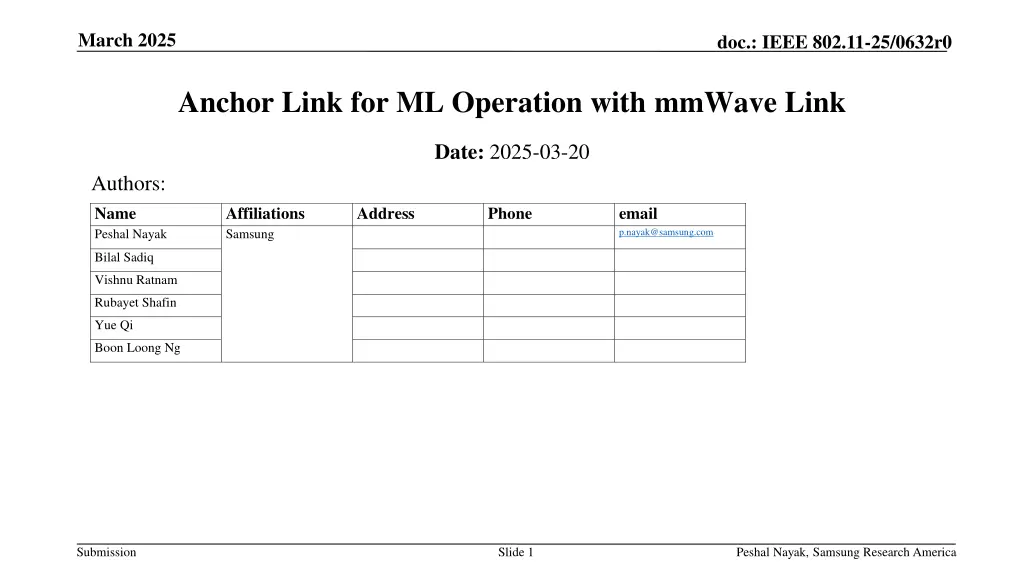
IEEE 802.11-25/0632r0: Enhancing mmWave Operation for IEEE 802.11 Technology
Explore the evolution of IEEE 802.11 technology and the increasing demand for high-throughput applications in various market segments. Discover the potential of mmWave bands in meeting these demands through non-standalone operations and multi-link communication procedures like Beaconing. Delve into the intricacies of Beaconing in 11ad/ay and its role in addressing challenges posed by mmWave propagation.
Download Presentation

Please find below an Image/Link to download the presentation.
The content on the website is provided AS IS for your information and personal use only. It may not be sold, licensed, or shared on other websites without obtaining consent from the author. If you encounter any issues during the download, it is possible that the publisher has removed the file from their server.
You are allowed to download the files provided on this website for personal or commercial use, subject to the condition that they are used lawfully. All files are the property of their respective owners.
The content on the website is provided AS IS for your information and personal use only. It may not be sold, licensed, or shared on other websites without obtaining consent from the author.
E N D
Presentation Transcript
March 2025 doc.: IEEE 802.11-25/0632r0 Anchor Link for ML Operation with mmWave Link Date: 2025-03-20 Authors: Name Peshal Nayak Affiliations Samsung Address Phone email p.nayak@samsung.com Bilal Sadiq Vishnu Ratnam Rubayet Shafin Yue Qi Boon Loong Ng Submission Slide 1 Peshal Nayak, Samsung Research America
March 2025 doc.: IEEE 802.11-25/0632r0 Need for mmWave Operation Over the years, IEEE 802.11 technology has expanded and diversified to cover multiple market segments [1]: Residential Enterprise Industrial, etc. There has been a growing demand for support of new applications with stringent throughput and latency requirements in these market segments: XR Proximity ranging and sensing, etc. The large bandwidth available in the mmWave bands provides a unique opportunity to meet the growing demand and support new types of applications Submission Slide 2 Peshal Nayak, Samsung Research America
March 2025 doc.: IEEE 802.11-25/0632r0 Non-standalone mmWave operation Non-standalone mmWave operation [1]: The PAR document describes a non-standalone operation (NSA) in unlicensed bands between 42 and 71 GHz. 802.11 device supporting the amendment should also support at least one of the sub-7.25 GHz unlicensed bands. The project scope proposes to expand the multi-link operation defined in sub-7.25 GHz band specifications to support non-standalone operation in the mmWave band. Submission Slide 3 Peshal Nayak, Samsung Research America
March 2025 doc.: IEEE 802.11-25/0632r0 Multi-link Operation Beaconing MLO introduced in 802.11be provides a set of procedures for communication between MLDs over one or more links. Beacon frame is transmitted on each link. Beacon frame carries information useful for non-AP MLD for MLO discovery, configuration updates such as AP removal, etc. Depending on the scenario, beacon frame body can contain a number of elements to achieve this objective. AP MLD Non-AP MLD NON-AP STA2 NON-AP STA1 NON-AP STA3 AP 2 AP 3 AP 1 5 GHz 6 GHz 5 GHz 6 GHz 2.4GHz 2.4GHz Beacon frame Beacon frame Beacon frame Fig. 1 Frame exchange for MLO discovery based on beacon transmission Fig. 2 Contents of a Beacon frame transmitted by an AP corresponding to the transmitted BSSID during MLO discovery Submission Slide 4 Peshal Nayak, Samsung Research America
March 2025 doc.: IEEE 802.11-25/0632r0 Beaconing in 11ad/ay Beacon Interval (BI) 802.11ad and ay have a beaconing design to cope with the challenges of mmWave propagation. A beacon interval (BI) in 11ad/ay contains Beacon header interval (BHI): Beacon transmission interval (BTI): includes a sweep of DMG beacons on different sectors to cover all possible directions Association beamforming training (A-BFT): used by STAs to train their antenna sector for communication with the AP Announcement Transmission Interval (ATI): management information exchanges between AP and associated beam-trained STAs. Data transmission interval (DTI) BHI DTI BTI A-BFT ATI A-BFT slot A-BFT slot Beacon sweeping Fig. 1 Beacon interval structure. Note: figure is not to scale Fig. 2 DMG Beacon frame format Submission Slide 5 Peshal Nayak, Samsung Research America
March 2025 doc.: IEEE 802.11-25/0632r0 Problem 1: Rethinking Beacon Design for NSA mmWave Operation Beacon design for NSA operation needs careful consideration: Overhead: 11bq will also need to sweep beacons in different direction. Sweeping a traditional 11be beacon (with ML info) will result in forbiddingly high overhead. Power consumption: A longer beacon also means a longer total sweep duration. This can require battery powered devices to stay awake for a longer total sweep duration (worse case). Frame errors: Shorter frame reduces chances of frame errors and enables edge devices to receive beacons efficiently. Submission Slide 6 Peshal Nayak, Samsung Research America
March 2025 doc.: IEEE 802.11-25/0632r0 Leveraging NSA Operation Non-standalone (NSA) operation must be leveraged to create a light weight beacon: Beacon contains only very basic information. A cookie, Minimum identifying information, etc. Remaining information transmission (e.g., STA profiles, other elements, etc.) can be offloaded to sub-7 GHz links. Submission Slide 7 Peshal Nayak, Samsung Research America
March 2025 doc.: IEEE 802.11-25/0632r0 Proposal 1: Minimalist Beacon Design for NSA mmWave Operation (1/2) Beacon design and procedure for NSA mmWave link operation must convey minimum information for operation of mmWave link Beacon can be periodically broadcasted like in legacy systems or can also be on demand. More details on this will be shared in a follow up contribution. Non-AP MLD can obtain other information from sub-7 links Submission Slide 8 Peshal Nayak, Samsung Research America
March 2025 doc.: IEEE 802.11-25/0632r0 Proposal 1: Minimalist Beacon Design for NSA mmWave Operation (2/2) The minimum that a mmWave beacon must contain: Information Comments 1. BSSID Entire BSSID (48 bits) OR preferably a few bits long time varying cookie 2. Transmit beam index 6 8 bits for beam index; implicitly or explicitly. 3. TSF Entire TSF OR preferably a partial TSF. 4. ?? After successfully decoding a beacon: STA side acquires: Receive beam, AP s transmit beam index, basic link quality for a given AP and TSF. AP side can acquire if necessary (possibly through sub-7 reporting): AP s transmit beam for a given STA, basic link quality. Submission Slide 9 Peshal Nayak, Samsung Research America
March 2025 doc.: IEEE 802.11-25/0632r0 Problem 2: NSA Cross-link Management Overhead Broadcast information: Other legacy beacon frame body content. Non-AP MLD specific information: STA specific beam management Beam tracking measurement and reporting DL beam training UL beam training Beam failure detection and recovery Possibly feature setup/teardown, cross link power save operation, .. NSA cross-link management overhead is expected to be significantly more than traditional ML operation. Submission Slide 10 Peshal Nayak, Samsung Research America
March 2025 doc.: IEEE 802.11-25/0632r0 How to Handle NSA Cross-link Management Overhead Design principles to for handling overhead of NSA cross link management: 1. For broadcast information: Minimize number of links on which broadcast information is duplicated. Avoid beacon bloating. 2. For non-AP MLD specific information: Allow load balancing for non-AP MLD specific management: should be distributed across different sub-7 GHz links. E.g., non-AP MLD 1 to K managed using link a, non-AP MLD K to N managed using link b, Submission Slide 11 Peshal Nayak, Samsung Research America
March 2025 doc.: IEEE 802.11-25/0632r0 Proposal 2: Anchor Link To enable an efficient NSA mmWave link operation, we propose to design an anchor link Information corresponding to the mmWave link will be selectively offloaded to an anchor link. A non-AP MLD that intends to use the mmWave link must also connect on an anchor link. Can consider multiple anchor links to avoid an overload on one anchor link. Fig. Anchor Link for NSA mmWave operation Submission Slide 12 Peshal Nayak, Samsung Research America
March 2025 doc.: IEEE 802.11-25/0632r0 Anchor Link Design Option 1: Single anchor link per AP MLD AP MLD maintains a single anchor link. Non-AP MLD that wants to use mmWave link connects on the single anchor link as well Option 2: One anchor link that is non-AP MLD specific Anchor link is configured per non-AP MLD. Either AP MLD configures one link of the non-AP MLD s links as an anchor link OR Non-AP MLD can chose one out of a candidate anchor link list Option 3: Multiple non-AP MLD specific anchor links Multiple of the sub-7 GHz can serve as anchors. Flexible/dynamic usage for NSA cross link management. Submission Slide 13 Peshal Nayak, Samsung Research America
March 2025 doc.: IEEE 802.11-25/0632r0 Anchor Link Indication An AP MLD can indicate which link is serving as an anchor link for mmWave link. E.g., indication in the per-STA profile of the anchor link. Non-AP MLD can ensure that it connects over at least one anchor link if it intends to use the mmWave link. Submission Slide 14 Peshal Nayak, Samsung Research America
March 2025 doc.: IEEE 802.11-25/0632r0 Rules for Link Setup and Reconfiguration A few basic rules may need to be defined for usage of the mmWave link: During initial link setup, the AP MLD can ensure that the non-AP MLD is connected over at least one anchor link if it intends to use the mmWave link. During link reconfiguration, the AP can ensure that the non-AP MLD adding the mmWave link has already connected over/is adding an anchor link. During link deletion, at least one anchor link should be maintained between the AP MLD and the non-AP MLD if the non-AP MLD intends to maintain the mmWave link Submission Slide 15 Peshal Nayak, Samsung Research America
March 2025 doc.: IEEE 802.11-25/0632r0 Conclusion In this contribution, we share two key proposals that for NSA mmWave operation: Proposal 1: Minimalist design approach for beacon on mmWave link. Proposal 2: Use of an anchor link for NSA mmWave operation. Submission Slide 16 Peshal Nayak, Samsung Research America
March 2025 doc.: IEEE 802.11-25/0632r0 Straw Poll 1 Do you agree that NSA mmWave link beacon shall provide minimal information necessary for operation of mmWave link? Note: Minimal information includes at least BSSID, transmit beam index, TSF. Submission Slide 17 Peshal Nayak, Samsung Research America
March 2025 doc.: IEEE 802.11-25/0632r0 Straw Poll 2 Do you agree that NSA mmWave operation should operate with the assistance of an Anchor link? Submission Slide 18 Peshal Nayak, Samsung Research America
March 2025 doc.: IEEE 802.11-25/0632r0 Straw Poll 3 Do you agree that an anchor link can carry the broadcast information corresponding to a mmWave link? Note: TBD on what broadcast information can be carried. Submission Slide 19 Peshal Nayak, Samsung Research America
March 2025 doc.: IEEE 802.11-25/0632r0 Straw Poll 4 Do you agree that an anchor link can carry non-AP MLD specific information corresponding to a non-AP MLD s affiliated STA operating on the mmWave link? Submission Slide 20 Peshal Nayak, Samsung Research America
March 2025 doc.: IEEE 802.11-25/0632r0 Reference [1] IEEE 802.11-24/0116, 802.11 IMMW Proposed PAR Submission Slide 21 Peshal Nayak, Samsung Research America


